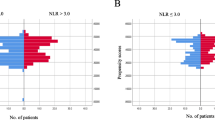Abstract
Background and aims
Selection of appropriate stage II colon cancer patients for adjuvant chemotherapy is critical for improving survival outcome. With the aim of identifying more high risk factors for stage II colon cancer, this study aimed to determine whether the neutrophil–lymphocyte ratio (NLR) is a predictor of surgical outcomes in patients with stage II colon cancer who do not receive adjuvant chemotherapy.
Materials and methods
We enrolled 1,040 stage II colon cancer patients who had undergone colectomy at a single institution between January 1995 and December 2005 and did not receive adjuvant chemotherapy.
Results
Of these 1,040 patients, 785 (75.5%) patients had a normal NLR and 255 (24.5%) had an elevated NLR. Those with an elevated NLR included patients ≥65 years, T4b cancer, carcinoembryonic antigen ≥5 ng/mL, and tumor obstruction or perforation. Patients with an elevated NLR had a significantly worse overall survival (OS) and worse disease-free survival (DFS) than did patients with a normal NLR. Cox regression analysis revealed that elevated NLR was an independent predictor of OS (P=0.012) but not DFS (P=0.255).
Conclusion
An elevated NLR is an independent predictor of OS but not DFS in stage II colon cancer patients who did not receive adjuvant chemotherapy. Preoperative NLR measurement in stage II colon cancer patients may be a simple method for identifying patients with a poor prognosis who can be enrolled in further trials of adjuvant chemotherapy.

Similar content being viewed by others
References
Moertel CG, Fleming TR, Macdonald JS et al (1990) Levamisole and fluorouracil as adjuvant therapy of resected colon carcinoma. N Engl J Med 322:352–358
QUASAR Collaborative Group, Gray R, Barnwell J, McConkey C et al (2007) Adjuvant chemotherapy vs observation in patients with colorectal cancer: a randomized study. Lancet 270:2020–2029
Benson AB, Schrag D, Somerfi MR et al (2004) American Society of Clinical Oncology recommendations on adjuvant chemotherapy for stage II colon cancer. J Clin Oncol 22:3408–3419
IMPACT B2 (1999) Efficacy of adjuvant fluorouracil and folinic acid in B2 colon cancer. International multicenter pooled analysis of B2 colon cancer trials investigators. J Clin Oncol 17:1356–1363
Marsoni S, International Multicenter Pooled Analysis of Colon Cancer Trials Investigators (2001) Efficacy of adjuvant fluorouracil and leucovorin in stage B2 and C colon cancer. Semin Oncol 28:14–19
Zaniboni A, Labianca R, Gruppo I et al (2004) Adjuvant therapy for stage II colon cancer: an elephant in the living room? Ann Oncol 15:1310–1318
Jemal A, Tiwari RC, Murray T et al (2004) American Cancer Society. Cancer statistics. CA Cancer J Clin 54:8–29
Version 2.2010, National Comprehensive Cancer Network. Practice Guidelines in Oncology-Colon Cancer. Principles of risk assessment for stage II disease. Col-D
Poplin EA, Benedetti JK, Estes NC et al (2005) Phase III Southwest Oncology Group 9415/Intergroup 0153 randomized trial of fluorouracil, leucovorin, and levamisole versus fluorouracil continuous infusion and levamisole for adjuvant treatment of stage III and high-risk stage II colon cancer. J Clin Oncol 23(9):1819–1825
Ueno H, Hawrylowicz CM, Banchereau J (2007) Immunological intervention in human diseases. J Transl Med 5:59
Zahorec R (2001) Ratio of neutrophil to lymphocyte counts—rapid and simple parameter of systemic inflammation and stress in critically ill. Bratisl Lek Listy 102(1):5–14
Nada K, Vesna M, Ivana K et al (2008) White blood cell count and neutrophil to lymphocyte ratio in uncomplicated and complicated canine babesiosis caused by Babesia canis. Veterinarski Archiv 78(4):321–330
Walsh SR, Cook EJ, Goulder F et al (2005) Neutrophil–lymphocyte ratio as a prognostic factor in colorectal cancer. J Surg Oncol 91:181–184
Halazun KJ, Aldoori A, Malik HZ et al (2008) Elevated preoperative neutrophil to lymphocyte ratio predicts survival following hepatic resection for colorectal liver metastases. Eur J Surg Oncol 34:55–60
Halzaun KJ, Hardy MA, Rana AA et al (2009) Negative impact of neutrophil–lymphocyte ratio on outcome after liver transplantation for hepatocellular carcinoma. Ann Surg 250(1):141–151
Kao SC, Pavlakis N, Harvie R et al (2010) High blood neutrophil-to-lymphocyte ratio is an indicator of poor prognosis in malignant mesothelioma patients undergoing systemic therapy. Clin Cancer Res 16(23):5805–5813
Printz C (2010) New AJCC Cancer Staging Manual reflects changes in cancer knowledge. Cancer 116:2–3
Balkwill F, Mantovani A (2001) Inflammation and cancer: back to Virchow? Lancet 357:539–545
Coussens LM, Werb Z (2002) Inflammation and cancer. Nature 420:860–867
Cho HB, Hur HW, Kim SW et al (2009) Pre-treatment neutrophil to lymphocyte ratio is elevated in epithelial ovarian cancer and predicts survival after treatment. Cancer Immunol Immunother 58:15–23
Fondevila C, Metges JP, Fuster J (2004) p53 and VEGF expression are independent predictors of tumour recurrence and survival following curative resection of gastric cancer. Br J Cancer 90(1):206–215
Gunter MJ, Stolzenberg-Solomon R, Cross AJ et al (2006) A prospective study of serum C-reactive protein and colorectal cancer risk in men. Cancer Res 66:2483–2487
Wong VK, Malik HZ, Hamady ZZ (2007) C-reactive protein as a predictor of prognosis following curative resection for colorectal liver metastases. Br J Cancer 29:222–225
McMillan DC, Canna K, McArdle CS (2003) Systemic inflammatory response predicts survival following curative resection of colorectal cancer. Br J Surg 90:215–219
Wolmark N, Fisher B, Wieand HS (1984) The prognostic significance of preoperative carcinoembryonic antigen levels in colorectal cancer. Results from NSABP clinical trials. Ann Surg 199:375–382
Author information
Authors and Affiliations
Corresponding author
Rights and permissions
About this article
Cite this article
Hung, HY., Chen, JS., Yeh, C.Y. et al. Effect of preoperative neutrophil–lymphocyte ratio on the surgical outcomes of stage II colon cancer patients who do not receive adjuvant chemotherapy. Int J Colorectal Dis 26, 1059–1065 (2011). https://doi.org/10.1007/s00384-011-1192-x
Accepted:
Published:
Issue Date:
DOI: https://doi.org/10.1007/s00384-011-1192-x




